[Pass Ensure VCE Dumps] PassLeader Free 70-686 PDF Study Guide and VCE Dumps (91-110)
Passing 70-686 exam with premium 70-686 exam dumps! PassLeader are offering the newest 200q 70-686 vce dumps and 70-686 pdf dumps including all the new added 70-686 exam questions, which are 100% valid for passing the 70-686 exam. PassLeader provide PDF and VCE format exam 70-686 briandumps with free version VCE player! Visit passleader.com now and download the 100% passing guarantee 200q 70-686 vce and pdf dumps to achieve 70-686 certification today! keywords: 70-686 exam,200q 70-686 exam dumps,200q 70-686 exam questions,70-686 pdf dumps,70-686 vce dumps,70-686 braindumps,70-686 practice test,70-686 study guide,Pro: Windows 7, Enterprise Desktop Administrator Exam 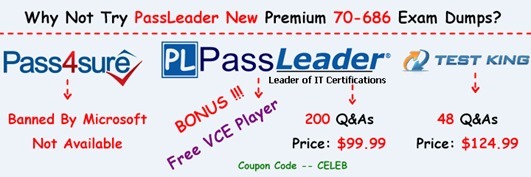
QUESTION 91
You use a computer named Client02 to manage the BitLocker configuration on a remote computer named Client01. A new company policy states that when BitLocker is used, you must be able to access the data in case of a system failure. You need to comply with the company policy. Using manage-bde, how should you achieve this goal? (To answer, drag the appropriate parameter from the list of options to the correct location or locations in the work area.)
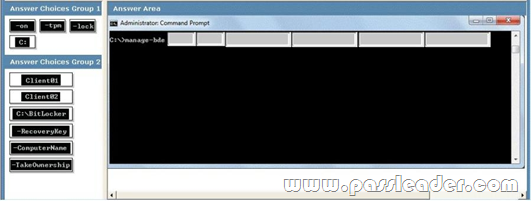 Answer:  QUESTION 92
A network has a single domain with 1,000 client computers that run Windows 7. A large number of software installation scripts are configured to run on the client computers. You need to recommend a Group Policy setting that allows users to log on to their computers as soon as possible at first boot. What should you recommend?
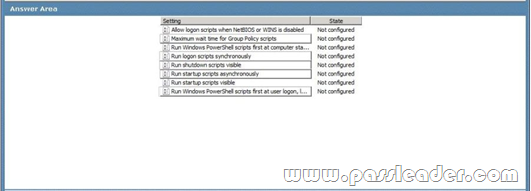 Answer:
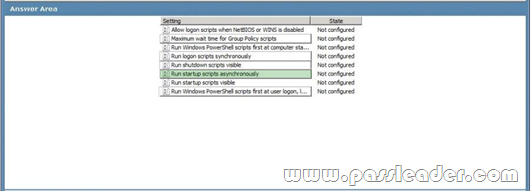 QUESTION 93
A company network includes Windows 7 client computers and DirectAccess. When using DirectAccess, users cannot connect to the companys internal resources. You need to create a batch file that users can execute to trace all network traffic for DirectAccess from their home computers. Which command should you use? To answer, drag the appropriate terms from the list of terms to the correct location or locations in the work area.
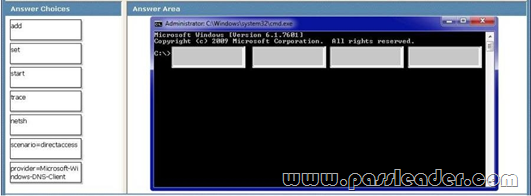 Answer:
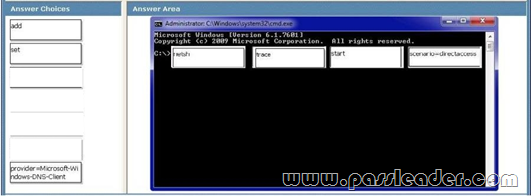 QUESTION 94
A user is unable to log on to a client computer that runs Windows 7. The user receives an error message that says The local policy of this system does not permit you to logon interactively. The user belongs only to the Users group. You need to ascertain which policy in the local security policy must be modified. Which security policy should you select? To answer, select the appropriate policy in the work area.
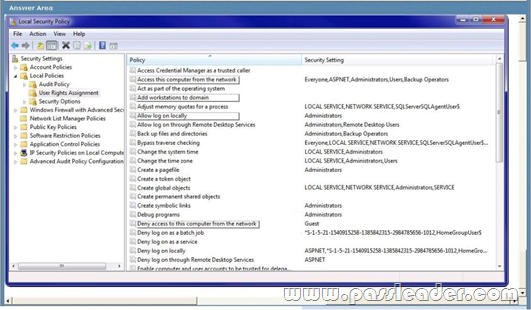 Answer:
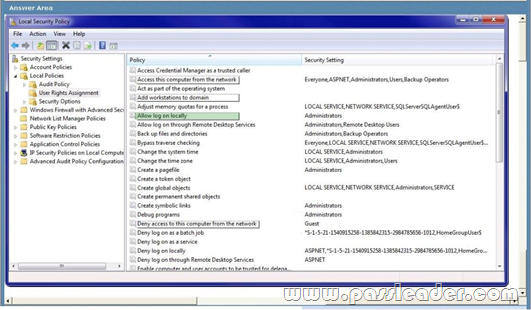 QUESTION 95
You upgrade all of an organization's client computers to Windows 7. After the upgrade, a specific legacy application does not function correctly. You need to generate a list of all the computers that have the legacy application installed. Which two actions should you perform? (To answer, move the appropriate action from the list of actions to the answer area and arrange them in the correct order.)
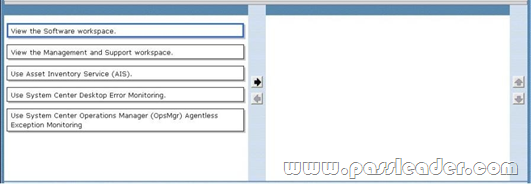 Answer:
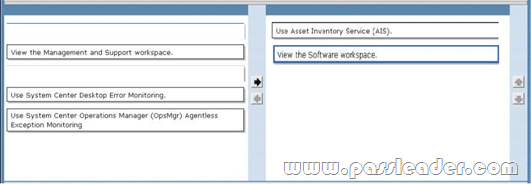 QUESTION 96
You are using Windows Deployment Services (WDS) to deploy new images of Windows 7 to 64-bit computers. Technicians receive the error message shown in the exhibit when they attempt to boot by using PXE. You need to ensure that the technicians can boot the client computers by using PXE. What should you do? (Choose all that apply.)
 A. Run the bcdedit /set {ntldr} description "Windows 7 32-bit" command.
B. Add a 64-bit boot image to the WDS server.
C. Add a 64-bit install image to the WDS serve
D. Add a 32-bit boot image to the WDS server.
E. Run the bcdedit /set {ntldr} description "Windows 7 64-bit" command.
F. Add a 32-bit install image to the WDS server. Answer: BD QUESTION 97
A company runs Windows Server 2008 R2 in an Active Directory Domain Services (AD DS) environment. Windows 7 is installed on all the companys client computers. You add a domain user account named User1 to the local Administrators group on a client computer named PC01. When User1 returns to the office, User1 does not have administrative access on PC01. When you inspect PC01, you find that the local Administrators group does not contain the user account. You need to ensure that User1 is a member of the local Administrators group. Which Group Policy setting should you select? To answer, select the appropriate Group Policy setting in the work area.
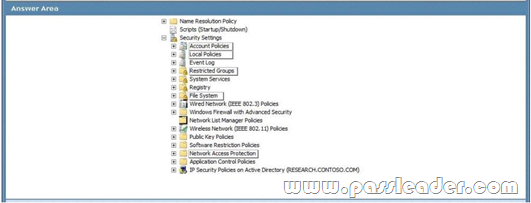 Answer:
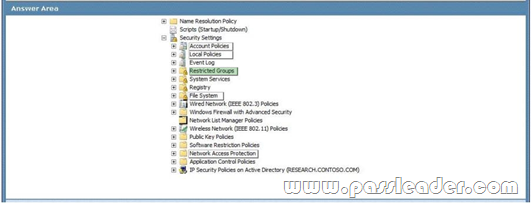 QUESTION 98
You are planning a deployment of Windows 7 on multiple client computers. You need to recommend a Windows 7 deployment solution that meets the following requirements:
* Must support the deployment of WIM or VHD
* Must support deployment by using multicast
What should you include in the recommendations? A. System Center Configuration Manager 2010
B. Microsoft Deployment Toolkit (MDT)
C. Deployment Image Servicing and Management (DISM)
D. Windows Deployment Services Answer: D QUESTION 99
You are planning a Windows 7 deployment infrastructure for a new company. You have the following requirements:
* Three domains
* 10,000 client computers
* No user interaction
You need to recommend a deployment infrastructure. What should you recommend? A. Deploy Microsoft System Center Configuration Manager 2007 R2. Design a zero-touch installation.
B. Deploy Microsoft System Center Virtual Machine Manager. Design a lite-touch installation.
C. Deploy Microsoft System Center Operations Manager 2007 R2. Design a lite-touch installation.
D. Deploy Microsoft Deployment Toolkit (MDT) 2010. Design a zero-touch installation. Answer: A QUESTION 100
Your network contains an Active Directory domain. You plan to deploy Windows 7 by using zero-touch installation. You need to test the zero-touch installation on a computer named computer1. You create a computer account for Computer1. What should you do next? A. Create a computer collection that contains the computer account for computer1.
B. Create a distribution group that contains the computer account for computer1.
C. Create a child domain and move the computer account for computer1 to the child domain.
D. Create a security group that contains the computer account for computer1. Answer: A

http://www.passleader.com/70-686.html QUESTION 101
Your company has a single Active Directory Domain Services (AD DS) domain and 1,000 client computers. You are planning to deploy Windows 7 Enterprise to the client computers. You need to design a zero-touch installation strategy. What should you use in your design? A. custom Windows 7 image on DVD
B. unattended installation
C. Windows Deployment Services (WDS)
D. Microsoft System Center Configuration Manager 2007 R2 Answer: D QUESTION 102
Your company has client computers that run Windows Vista. The company plans to upgrade the Windows Vista computers to Windows 7. The current configuration of all client computers in your company is based on a common Windows Vista image. Some branch offices use WAN connections to connect to the main office. You have the following requirements:
* Transfer all user data from the original Windows Vista installation to the new Windows 7 installation.
* Use the least amount of bandwidth while transferring the user data.
* Support the same migration strategy for all offices.
You need to design a user state migration strategy that supports the requirements. What should you do? A. Use the Deployment Image Servicing and Management (DISM) tool.
B. Use the User State Migration Tool (USMT) and a hard-link migration store.
C. Use Windows PE to perform an offline migration.
D. Use the multicast feature of Windows Deployment Services (WDS). Answer: C QUESTION 103
You are designing a Windows 7 deployment image. You plan to install Windows 7 Enterprise with a Multiple Activation Key (MAK). You need to add the MAK to the configuration pass by using an answer file. To which configuration pass should you add the MAK? A. the WindowsPE configuration pass
B. the Generalize configuration pass
C. the AuditSystem configuration pass
D. the Specialize configuration pass Answer: D QUESTION 104
All client computers in your network run Windows XP. Some of the computers are part of a secure network. Some of the computers connect to the network by using virtual private networking (VPN). You are planning to deploy Windows 7. You have the following requirements:
* Use a dedicated server for deployment.
* Use a single operating system image for deployment.
* Ensure that you can use removable media to deploy the image.
* Ensure that you can select which applications are installed onto a client computer at the time of deployment.
You need to design a deployment strategy that meets the requirements. What should you do? A. Use the Microsoft Deployment Toolkit to perform a lite-touch installation.
B. Use Windows Deployment Services on a network server to deploy Windows 7 by using an install image.
C. Using a Windows PE boot media, use ImageX to apply the image from a network share to the client computers.
D. Use System Center Configuration Manager 2007 R2 to perform a zero-touch installation. Answer: A QUESTION 105
You have a single Active Directory domain. All domain controllers run Windows Server 2003 with Service Pack 1 (SP1). You plan to store Windows BitLocker Drive Encryption recovery passwords in Active Directory. You need to recommend the solution that uses the least amount of administrative effort. What should you recommend? A. Upgrade the domain controller that has the role of operations master to Windows Server 2008 R2.
B. Upgrade all domain controllers to Windows Server 2008 R2.
C. Upgrade all domain controllers to Windows Server 2003 SP2.
D. Extend the Active Directory schema. Answer: D QUESTION 106
You create a Windows 7 deployment image that includes custom Internet Explorer branding and search providers. Your company decides to deploy all custom settings by using Group Policy. You need to restore the Internet Explorer settings in the deployment image to the Microsoft default settings. Which two actions should you perform? (Each correct answer presents part of the solution. Choose two.) A. Use the Reset Internet Explorer Settings (RIES) feature, and run the Remove Branding process on the deployment image.
B. Update the Internet Explorer Maintenance policy processing Group Policy object (GPO) settings for all computers.
C. Update the Internet Explorer Manage Add-ons settings for all computers.
D. Use the Reset Internet Explorer Settings (RIES) feature, and run the Reset process on the deployment image. Answer: AD QUESTION 107
Your network has client computers that run Windows 7. A custom Web-based application requires specific security settings. You need to prevent users from permanently modifying their Internet Explorer browsers security settings. What should you do? A. Reset the Internet Explorer settings
B. Restore the advanced settings in Internet Explorer
C. Use Windows Internet Explorer Maintenance (IEM) extension settings in Preference mode
D. Use Windows Internet Explorer Maintenance (IEM) extension settings in Normal mode Answer: D QUESTION 108
Your company has an Active Directory Domain Services (AD DS) forest with a single domain. The domain, organizational unit (OU), and Group Policy object (GPO) design is shown in the following diagram.
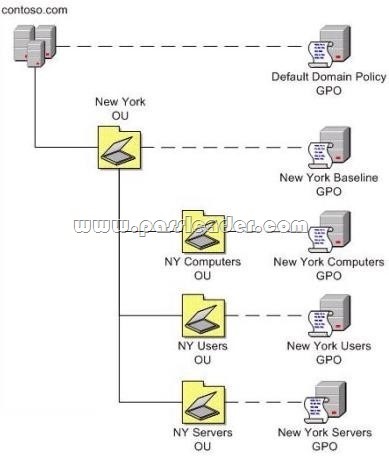
The NY Computers OU contains client computers that run either Windows Vista Enterprise or Windows 7 Enterprise. The New York Computers GPO defines software restriction policies (SRPs). You have the following requirements:
* SRPs must be used for only Windows Vista Enterprise client computers.
* AppLocker policies must be used for only Windows 7 Enterprise client computers.
* AppLocker policies must be defined by using Group Policy.
You need to design an AppLocker deployment that meets these requirements. What should you do? A. Create a new GPO that has the AppLocker settings, and link it to the NY Users OU.
B. Define the AppLocker settings in the New York Baseline GPO.
C. Define the AppLocker settings in the New York Users GPO.
D. Create a new GPO that has the AppLocker settings, and link it to the NY Computers OU. Answer: D QUESTION 109
You plan to use Windows PowerShell scripts to configure system settings when you deploy Windows 7. You need to ensure that Windows PowerShell scripts will run on the client computers during initial setup. A. Set the script execution policy to Restricted.
B. Set the script execution policy to RemoteSigned.
C. Use Group Policy preferences.
D. Set the script execution policy to AllSigned. Answer: A QUESTION 110
Your company has offices in several countries. You must test and validate all operating system images before you deploy them. You create a Windows 7 Enterprise master image that has all language packs installed. You test and validate the master image. You are planning to create regional images based on the master image. Each regional image will contain only the language pack that is necessary for a specific geographic region. You have the following requirements:
* Remove the language packs that are unnecessary for each region.
* Minimize the necessary testing and validation.
You need to create the regional images. What should you do? A. Run lpksetup.exe /u in unattended mode on the master image.
B. Deploy the master image to a target computer. Remove the unnecessary language packs, and then capture each regional image.
C. Service the master image online by using the Deployment Image Servicing and Management (DISM) tool.
D. Service the master image offline by using the Deployment Image Servicing and Management (DISM) tool. Answer: D

http://www.passleader.com/70-686.html
|














